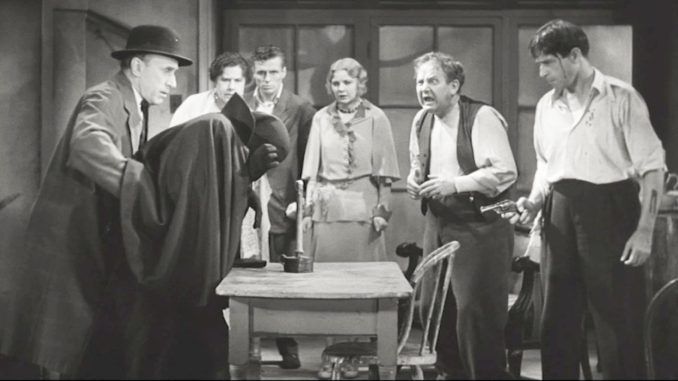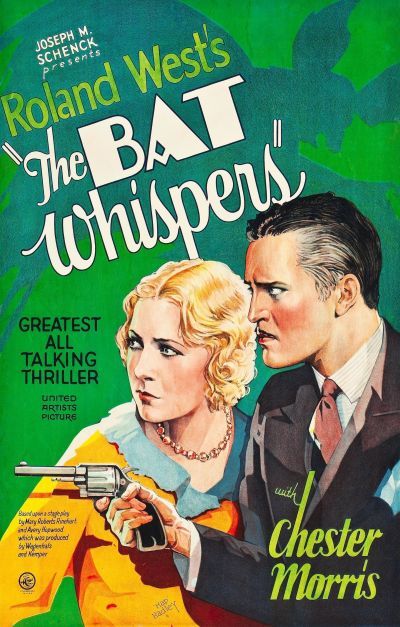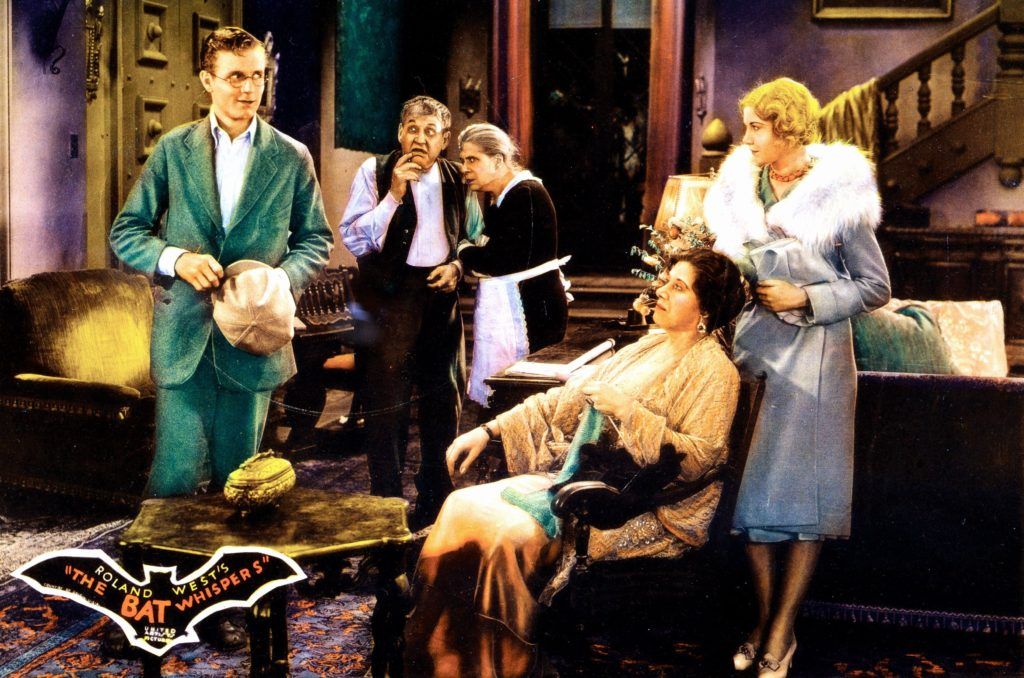
Rating: C+
Dir: Roland West
Star: Chester Morris, Una Merkel, Grayce Hampton, Maude Eburne
This year is the calm before the veritable horror storm of 1931, with The Bat Whispers the only genre title to reach even five hundred votes on the IMDb. And its horror credentials are a little dubious: Wikipedia calls it a mystery, and that might actually be closer. We’ll see. Mind you, the horror genre as such arguably didn’t exist yet. Instead, we had horror-adjacent films like Ingagi, an obvious – although fairly racist – inspiration for King Kong, in which an ape kidnaps a white woman for… Oh, y’know. It’s a pseudo-documentary with a lot of footage of African wildlife – basically, the entire first hour – narration in place of acting, and a staggeringly bad gorilla suit. You could make the case that it’s the first “found footage” horror movie. Not least because it sucks, a tradition to which most of its descendants adhere.
I was sorely tempted to go for the next most popular entry after Whispers: I mean, it’s called Hellbound Train. Sadly, it’s only fifty minutes long, although seems to cram a lot in. It’s available on the Library of Congress website, where the description reads: “A car-by-car dramatization of the sins of the Jazz Age (including gambling, dancing, alcohol, and the mistreatment of animals), presided over by a horned devil, culminating in a colossal derailment.” A silent film, it was made by husband and wife team James and Eloyce Gist as an evangelical tool. They’d travel the country preaching and showing the film – so basically, it’s a religious version of the likes of Reefer Madness. By most accounts though, it’s not very good, and about as subtle as it sounds.
 We also have to cross off the lost films, like The Cat Creeps and its Spanish-language version, shot simultaneously, La voluntad del muerto. Among these, the one I’m most curious about is probably Die zwölfte Stunde. As you would imagine, this is German – but was actually a post-dubbed sound film adaptation of F.W. Murnau’s Nosferatu. Directed by Waldemar Ronger, he changed all the cast names and added both scenes he shot and material discarded by Murnau. It was released at the time without official credit to the original director. Somewhat ironic, because Nosferatu was itself an uncredited adaptation of Dracula. Which is why it nearly ended up becoming lost entirely, after Bram Stoker’s estate sued.
We also have to cross off the lost films, like The Cat Creeps and its Spanish-language version, shot simultaneously, La voluntad del muerto. Among these, the one I’m most curious about is probably Die zwölfte Stunde. As you would imagine, this is German – but was actually a post-dubbed sound film adaptation of F.W. Murnau’s Nosferatu. Directed by Waldemar Ronger, he changed all the cast names and added both scenes he shot and material discarded by Murnau. It was released at the time without official credit to the original director. Somewhat ironic, because Nosferatu was itself an uncredited adaptation of Dracula. Which is why it nearly ended up becoming lost entirely, after Bram Stoker’s estate sued.
We are, however, stuck with The Bat Whispers. Wikipedia is right: it’s a mystery, and not horror, in a way anyone today knows the term. Although, if you squint hard enough, could it perhaps be seen as an early predecessor to the home invasion genre? The residents of a remote manor house, owned by the president of a bank, are terrorized (for a very loose definition of the word) by a masked intruder, known as The Bat. He’s a master criminal, with a track record of daring heists and taunting the authorities. The Bat is seeking the proceeds from a recent robbery at the bank, which may have been hidden in a secret room. It’s a lot of cash – half a million dollars, the equivalent of almost ten in today’s money – so the stakes are high.
This was adapted from, The Bat, a 1920 play written by Mary Roberts Rinehart and Avery Hopwood which has a successful run in New York and London. When it closed on Broadway, it had become the second-longest-running production there to that point. It had previously become 1926’s silent movie, The Bat, and would be adapted under the same title in 1959. The latter is likely closer to horror, starring Vincent Price and Agnes Moorehead. The decision to add “whispers” to its title here was to stress the use of the then newfangled sound technology. But its plot has not aged well, now feeling like a series of clichés, and on-screen, its origins as a stage-play are obvious.
Which is a shame, since visually, there are some striking and innovative moments. This was one of the first films shot in widescreen. West actually filmed two versions of it with two different cinematographers. Ray June shot it using a standard 35 mm camera, while the other was filmed by Robert H. Planck, using a recently invented 65 mm “Magnifilm” camera. Reaction to the latter version was muted, and it would be another two decades before the technology would become a standard part of the cinematic arsenal. Both editions of the film were considered lost for years, before being recovered. The 65mm print was found in the estate of silent star Mary Pickford, who willed her film collection to the Library of Congress after her death in 1979.
 Equally innovative is the use of camera movement. As we’ve headed back in time for this feature, I’ve become used to the camera being static – in part because they were so large and bulky, that moving them during a shot was severely problematic. But here, there are a number of shots which are impressively kinetic. The opening would be one: a shot of a clock tower is followed by the camera swooping down to its base. The model-work involved before the cut to live-action footage is obvious to modern eyes, yet it’s still something I did not expect to see in a production of this vintage. Another moment sees the camera following the actor as he moves into the grounds, and I was almost in shock when it started to move.
Equally innovative is the use of camera movement. As we’ve headed back in time for this feature, I’ve become used to the camera being static – in part because they were so large and bulky, that moving them during a shot was severely problematic. But here, there are a number of shots which are impressively kinetic. The opening would be one: a shot of a clock tower is followed by the camera swooping down to its base. The model-work involved before the cut to live-action footage is obvious to modern eyes, yet it’s still something I did not expect to see in a production of this vintage. Another moment sees the camera following the actor as he moves into the grounds, and I was almost in shock when it started to move.
This helped sustain interest, when the plot and some actors struggled to do so. I did quite enjoy the relationship between tenant Cornelia Van Gorder (Hampton) and her comic relief maid, Lizzie (Eburne). The latter’s attempts to follow her mistress at one point are spurned with, “You’re trouble enough on the ground floor. You’d be a nuisance on the roof.” There’s a suspicious foreigner, Dr Venrees, with a good performance by Gustav von Seyffertitz – or, to give him his full name, Gustav Carl Viktor Bodo Maria von Seyffertitz. But Morris, playing Detective Anderson, and leading lady Merkel, as Dale Van Gorder, make very little impression. The former comes out “on stage” at the end, asking the audience to keep the secret of the Bat’s identity. I’ve got your back there, Detective.
This article is part of our October 2025 feature, 31 Days of Vintage Horror.
